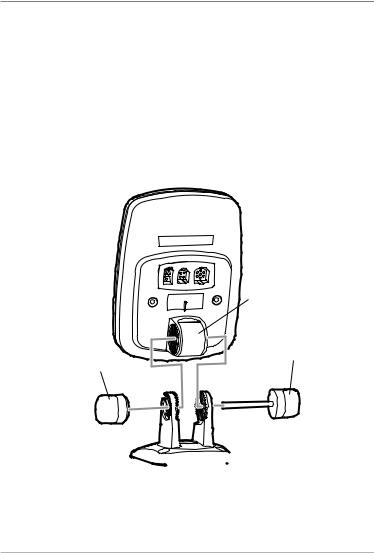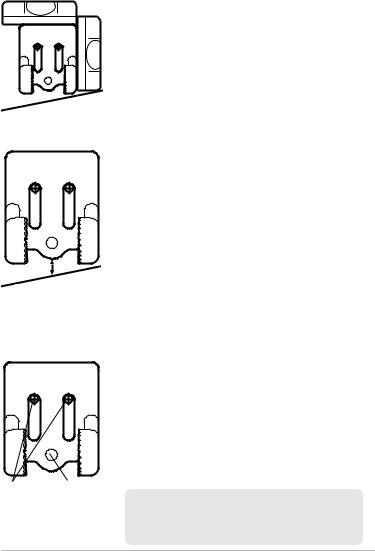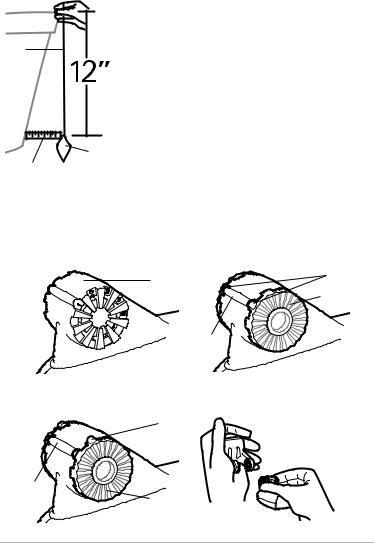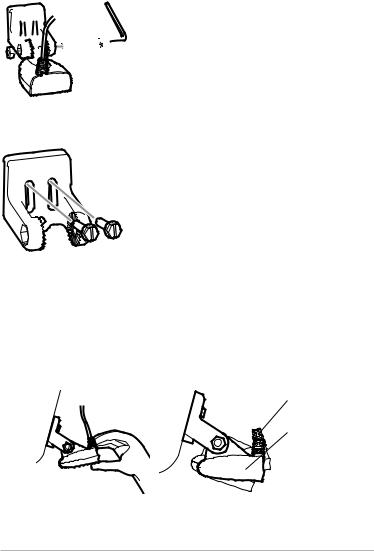Humminbird 196cxi, 196ci, 195c, 165, 175 Owner's Manual
...
PiranhaMAX165, 175,176i,195c,& 196cii
Installation and Operations Manual
532030-1_A

Thank You!
Thank you for choosing Humminbird®, the #1 name in Fishfinders. Humminbird® has built its reputation by designing and manufacturing top-quality, thoroughly reliable marine equipment. Your Humminbird® accessory is designed for trouble-free use in even the harshest marine environment. In the unlikely event that your Humminbird® accessory does require repairs, we offer an exclusive Service Policy - free of charge during the first year after purchase, and available at a reasonable rate after the one-year period. For complete details, see the separate warranty card included with your accessory. We encourage you to read this operations manual carefully in order to get full benefit from all the features and applications of your Humminbird® product.
Contact our Customer Resource Center at 1-800-633-1468 or visit our Web site at humminbird.com.
The following models are covered in this manual:
•PiranhaMAX 165 - Single Beam, 240 V x 160 H Monochrome Display
•PiranhaMAX 175 - Dual Beam, 240 V x 160 H Monochrome Display
•PiranhaMAX 176i - Dual Beam, 240 V x 160 H Monochrome Display
•PiranhaMAX 195c - Dual Beam,320 V x 240 H Transmissive ColorDisplay
•PiranhaMAX 196ci - Dual Beam,320 V x 240 H Transmissive Color Display
WARNING! This device should not be used as a navigational aid to prevent collision, grounding, boat damage, or personal injury. When the boat is moving, water depth may change too quickly to allow time for you to react. Always operate the boat at very slow speeds if you suspect shallow water or submerged objects.
WARNING! Disassembly and repair of this electronic unit should only be performed by authorized service personnel. Any modification of the serial number or attempt to repair the original equipment or accessories by unauthorized individualswill void the warranty.
WARNING! Do not travel at high speed with the unit cover installed. Remove the unit cover before traveling at speeds above 20 mph.
WARNING! This product contains chemicals known to the State of California to cause cancer and/or reproductive harm.
i

NOTE: Some features discussed in this manual require a separate purchase, and some features are only available on international models. Every effort has been made to clearly identify those features. Please read the manual carefully in order to understand the full capabilities of your model.
NOTE: The illustrations in this manualmay not look the same as your product,but your unit will function in the same way.
NOTE: To purchase accessories for your control head, visit our web site at humminbird.com or contact our Customer Resource Center at 1-800-633-1468.
NOTE: The procedures and features described in this manual are subject to change without notice. This manual was written in English and may have been translated to another language. Humminbird® is not responsible for incorrect translations or discrepancies between documents.
ROHS STATEMENT: Product designed and intended as a fixed installation or part of a system in a vessel may be considered beyond the scope of Directive 2002/95/EC of the European Parliament and of the Council of 27 January 2003 on the restrictionof the use of certain hazardous substances in electrical and electronicequipment.
ATTENTION INTERNATIONAL CUSTOMERS: Products sold in the U.S. are not intended for use in the international market. Humminbird®internationalunits provide international features and are designed to meet country and regional regulations. Languages, maps, time zones, units of measurement, and warranty are examples of features that are customized for Humminbird® internationalunits purchasedthrough our authorized international distributors.
To obtain a list of authorized international distributors, please visit our Web site at humminbird.com or contact our Customer Resource Center at (334) 687-6613.
Humminbird®, Fish ID+™, Structure ID®, and WhiteLine™ are trademarked by or registered trademarks of Johnson Outdoors Marine Electronics, Inc.
Baekmuk Batang, Baekmuk Dotum, Baekmuk Gulim, and Baekmuk Headline are registered trademarks owned by Kim Jeong-Hwan.
© 2012 Johnson Outdoors Marine Electronics, Inc. All rights reserved.
ii

Table of Contents
Installation Overview |
1 |
Fixed Control Head Installation |
2 |
Determine Where to Mount . . . . . . . . . . . . . . . . . . . . . . . . . . . . . . . . . . . . . . . . . 2 Connect the Power Cable to the Boat . . . . . . . . . . . . . . . . . . . . . . . . . . . . . . . . . 2 Assemble the Control Head Base . . . . . . . . . . . . . . . . . . . . . . . . . . . . . . . . . . . . . 4 Route the Control Head Cables Under the Deck . . . . . . . . . . . . . . . . . . . . . . . . . 5 Attach the Control Head to the Base . . . . . . . . . . . . . . . . . . . . . . . . . . . . . . . . . . 6 Attach the Cables to the Control Head . . . . . . . . . . . . . . . . . . . . . . . . . . . . . . . . 7
Transom Transducer Installation Overview |
8 |
Transom Transducer Installation |
9 |
Locate the Transducer Mounting Position . . . . . . . . . . . . . . . . . . . . . . . . . . . . . . 9
Prepare the Mounting Location . . . . . . . . . . . . . . . . . . . . . . . . . . . . . . . . . . . . . 10
Assemble and Mount the Transducer . . . . . . . . . . . . . . . . . . . . . . . . . . . . . . . . 12
Route the Cable. . . . . . . . . . . . . . . . . . . . . . . . . . . . . . . . . . . . . . . . . . . . . . . . . . 16
Test and Finish the Installation . . . . . . . . . . . . . . . . . . . . . . . . . . . . . . . . . . . . . . 18
PiranhaMAX Portable Case Assembly |
20 |
Assemble the Control Head Base . . . . . . . . . . . . . . . . . . . . . . . . . . . . . . . . . . . . 21 Assemble the Base and Handle . . . . . . . . . . . . . . . . . . . . . . . . . . . . . . . . . . . . . 22 Attach the Control Head to the Base and Handle . . . . . . . . . . . . . . . . . . . . . . . 23 Route the Cables . . . . . . . . . . . . . . . . . . . . . . . . . . . . . . . . . . . . . . . . . . . . . . . . . 24 Assemble the Portable Case . . . . . . . . . . . . . . . . . . . . . . . . . . . . . . . . . . . . . . . . 27 Charge and Install the Battery . . . . . . . . . . . . . . . . . . . . . . . . . . . . . . . . . . . . . . 27 Assemble the Transducer Mounting Bracket . . . . . . . . . . . . . . . . . . . . . . . . . . . 28 Stow the Portable Transducer and Battery Charger into the Portable Case. . . 29
Installing the Portable Case on the Boat |
30 |
Connect the Transducer and Power Cables to the Portable Case. . . . . . . . . . . 30 Attach the Portable Case to the Boat. . . . . . . . . . . . . . . . . . . . . . . . . . . . . . . . . 31
Mounting the Portable Transducer |
32 |
Test the Transducer Prior to Installation. . . . . . . . . . . . . . . . . . . . . . . . . . . . . . . 32 Mount the Portable Transducer on the Boat . . . . . . . . . . . . . . . . . . . . . . . . . . . 32
iii

Table of Contents |
|
Moving the Portable Fishfinder |
34 |
Power ON and OFF |
35 |
PiranhaMAX Sonar Technology |
36 |
Single Beam Sonar . . . . . . . . . . . . . . . . . . . . . . . . . . . . . . . . . . . . . . . . . . . . . . . |
37 |
Dual Beam Sonar. . . . . . . . . . . . . . . . . . . . . . . . . . . . . . . . . . . . . . . . . . . . . . . . . |
37 |
What YouSee on the Display |
38 |
How GPS Works |
39 |
The PiranhaMAX Control Head |
40 |
Key Functions |
41 |
POWER/MENU Key . . . . . . . . . . . . . . . . . . . . . . . . . . . . . . . . . . . . . . . . . . . . . . . |
41 |
UP and DOWN Arrow Keys . . . . . . . . . . . . . . . . . . . . . . . . . . . . . . . . . . . . . . . . . |
41 |
CHECK/ENTER Key. . . . . . . . . . . . . . . . . . . . . . . . . . . . . . . . . . . . . . . . . . . . . . . . |
42 |
How to Use the Menu System |
43 |
Set Up the Control Head |
45 |
Contrast (PiranhaMAX 165, 175, and 176i models only) . . . . . . . . . . . . . . . . . . . . . . . . . . . . |
46 |
Fish ID+™ (Sonar View only). . . . . . . . . . . . . . . . . . . . . . . . . . . . . . . . . . . . . . . . . . |
46 |
Bottom View (Sonar View only). . . . . . . . . . . . . . . . . . . . . . . . . . . . . . . . . . . . . . . . |
46 |
Reset . . . . . . . . . . . . . . . . . . . . . . . . . . . . . . . . . . . . . . . . . . . . . . . . . . . . . . . . . . |
48 |
Language (International Models only). . . . . . . . . . . . . . . . . . . . . . . . . . . . . . . . . . . . |
48 |
Units - Distance (Units submenu) . . . . . . . . . . . . . . . . . . . . . . . . . . . . . . . . . . . . . . |
48 |
Units - Speed (Units submenu) . . . . . . . . . . . . . . . . . . . . . . . . . . . . . . . . . . . . . . . . |
48 |
Units - Temp (International Models only, Units submenu) . . . . . . . . . . . . . . . . . . . . . . |
48 |
Units - Depth (International Models only, Units submenu) . . . . . . . . . . . . . . . . . . . . . |
48 |
Views |
49 |
Display a View . . . . . . . . . . . . . . . . . . . . . . . . . . . . . . . . . . . . . . . . . . . . . . . . . . . |
49 |
Status View |
50 |
Sonar View |
51 |
iv

Table of Contents
Sonar Menu |
52 |
View . . . . . . . . . . . . . . . . . . . . . . . . . . . . . . . . . . . . . . . . . . . . . . . . . . . . . . . . . . . 53
Depth Range . . . . . . . . . . . . . . . . . . . . . . . . . . . . . . . . . . . . . . . . . . . . . . . . . . . . 53
Sensitivity. . . . . . . . . . . . . . . . . . . . . . . . . . . . . . . . . . . . . . . . . . . . . . . . . . . . . . . 53
Zoom . . . . . . . . . . . . . . . . . . . . . . . . . . . . . . . . . . . . . . . . . . . . . . . . . . . . . . . . . . 54
Chart Speed . . . . . . . . . . . . . . . . . . . . . . . . . . . . . . . . . . . . . . . . . . . . . . . . . . . . . 54
Filter . . . . . . . . . . . . . . . . . . . . . . . . . . . . . . . . . . . . . . . . . . . . . . . . . . . . . . . . . . . 55
Light . . . . . . . . . . . . . . . . . . . . . . . . . . . . . . . . . . . . . . . . . . . . . . . . . . . . . . . . . . . 55
Beam Select. . . . . . . . . . . . . . . . . . . . . . . . . . . . . . . . . . . . . . . . . . . . . . . . . . . . . 55
Track View (PiranhaMAX 176i and 196ci only) |
56 |
Track Menu (PiranhaMAX 176i and 196ci only) |
57 |
View . . . . . . . . . . . . . . . . . . . . . . . . . . . . . . . . . . . . . . . . . . . . . . . . . . . . . . . . . . . 58
Zoom . . . . . . . . . . . . . . . . . . . . . . . . . . . . . . . . . . . . . . . . . . . . . . . . . . . . . . . . . . 58
COG Vector. . . . . . . . . . . . . . . . . . . . . . . . . . . . . . . . . . . . . . . . . . . . . . . . . . . . . . 58
Clear Track . . . . . . . . . . . . . . . . . . . . . . . . . . . . . . . . . . . . . . . . . . . . . . . . . . . . . . 58
Delete. . . . . . . . . . . . . . . . . . . . . . . . . . . . . . . . . . . . . . . . . . . . . . . . . . . . . . . . . . 58
Delete All . . . . . . . . . . . . . . . . . . . . . . . . . . . . . . . . . . . . . . . . . . . . . . . . . . . . . . . 59
Light . . . . . . . . . . . . . . . . . . . . . . . . . . . . . . . . . . . . . . . . . . . . . . . . . . . . . . . . . . . 59
Alarms |
60 |
Maintenance |
62 |
Troubleshooting |
64 |
PiranhaMAX 165 Specifications |
66 |
PiranhaMAX 175/176i/195c/196ci Specifications |
67 |
Contact Humminbird® |
69 |
NOTE: Entries in this Table of Contents which list (InternationalOnly) are only available on products sold outside of the U.S. by our authorized International Distributors. It is important to note that products sold in the U.S. are not intended for resale in the international market. To obtain a list of authorized InternationalDistributors,please visit our Web site at humminbird.com or contact our Customer Resource Center at 1-800-633-1468 to locate the distributor nearest you.
v

Installation Overview
Before you start installation, we encourage you to read these instructions carefully in order to get the full benefit from your PiranhaMAX.
There are three basic installation tasks that you must perform for the PiranhaMAX:
•Installing the Control Head
•Installing the Transducer
•Testing the complete installation and locking the transducer position.
NOTE: In addition to the hardware supplied with your transducer, you will need a powered hand drill and various drill bits, various hand tools, including a ruler or straightedge, a level, a 12" plumb line (weighted string or monofilament line), marker or pencil, safety glasses and dust mask, and marine-grade silicone sealant.
NOTE: If you have purchased a PiranhaMAX Portable unit, proceed to PiranhaMAX Portable Case Assembly for installation instructions. If you are planning a fixed installation, proceed to Fixed Control Head Installation.
1 |
Installation Overview |

Fixed Control Head Installation
1. Determine Where to Mount
Begin the installation by determining where to mount the control head. Consider the following to determine the best location:
Figure 1
Figure 2
•To check the location planned for the control head, test run the cables for the power and transducer. See Transom Transducer Installation in order to plan the location of the transducer and cable route.
•The mounting surface should be stable enough to protect the control head from excessive wave shock and vibration, and should provide visibility while in operation.
•Your PiranhaMAX uses a tilt and swivel mounting base. The mounting area should allow sufficient room for the unit to pivot and swivel freely, and for easy removal and installation (Figures 1 and 2).
2. Connect the Power Cable to the Boat
A 6' long power cable is included to supply power to the control head. You may shorten or lengthen the cable using 18 gauge multi-stranded copper wire.
CAUTION! Some boats have 24 or 36 Volt electric systems, but the control head MUST be connected to a 12 VDC power supply.
The control head power cable can be connected to the electrical system of the boat at two places: a fuse panel usually located near the console, or directly to the battery.
NOTE: Make sure that the power cable is not connectedto the controlhead at the beginning of this procedure.
Fixed Control Head Installation |
2 |

NOTE: Humminbird® is not responsible for over-voltage or over-current failures. The control head must haveadequate protection through the proper selectionand installation of a 1 amp fuse.
POSITIVE |
GROUND |
Figure 3
Figure 4
1a. If a fuse terminal is available, use crimp-on type electrical connectors (not included) that match the terminal on the fuse panel. Attach the black wire to ground (-), and the red wire to positive (+) 12 VDC power (Figure 3). Install a 1 amp fuse (not included) for protection of the unit. Humminbird® is not responsible for overvoltage or over-current failures.
or...
1b. If you need to wire the control head directly to a battery, obtain and install an inline fuse holder and a 1 amp fuse (not included) for the protection of the unit (Figure 4). Humminbird® is not responsible for over-voltage or over-current failures.
NOTE: In order to minimize the potential for interferencewith other marine electronics, a separate power source (such as a second battery) may be necessary.
3 |
Fixed Control Head Installation |

3. Assemble the Control Head Base
Your control head base will have a tilt and swivel mount. See the instructions below to assemble and mount the control head base.
Tilt and Swivel Mount
Control Head Base Assembly




 Mount Arms
Mount Arms
Base
Swivel
Ring
Countersink
Side Out
Arm Screws, 



4 #6 x7/16"
Figure 5
To assemble a tilt and swivel mount:
1.Insert the mount arms into the base. Then, hold the mount arms in place as you turn the base upside down.
2.Insert the swivel ring into the base, with the countersink holes for the arm screws facing out.
3.Secure the mount arms with the four #6 screws provided (Figure 5).
Hand tighten only!
4.Set the assembled control head base in place on the mounting surface. Mark the four mounting screw locations with a pencil or punch.
5.Set the base aside, and drill the four mounting screw holes using a 9/64" bit.
6.Proceed to Route the Control Head Cables Under the Deck.
Fixed Control Head Installation |
4 |

4. Route the Control Head Cables Under the Deck
Use the following steps to route the control head cables under the deck.
NOTE: Under the deck cable routing is not always possible. If this is not an option, the cables should be routed and secured above deck.
NOTE: See Transom Transducer Installation in order to plan the location of the transducer and cable route.
Tilt and Swivel Mount
Control Head Base
Tilt and Swivel Mount:
1a. Mark and drill a 3/4" hole as shown in Figure 6. Route the cables through the hole. The cables will exit through the center hole on the control head base.
 1b. If the cables cannot be routed directly beneath the control head base, mark and drill a 3/4" hole that will allow you to run the cables close to the control head base.
1b. If the cables cannot be routed directly beneath the control head base, mark and drill a 3/4" hole that will allow you to run the cables close to the control head base.
3/4
” 
19 mm
Figure 6
5 |
Fixed Control Head Installation |

5. Attach the Control Head to the Base
Follow these steps to attach the control head to the already-assembled base:
NOTE: The transducer cable and power cable should be routed prior to securing the mounting bracket to the deck.
1.Apply marine-grade silicone sealant to the drilled holes for the mounting bracket.
2.Place the mounting bracket on the mounting surface, aligning with the drilled holes.
3.Insert the four #8 Phillips countersink wood screws into the mounting holes. Hand tighten only!
Pivot Knuckle
Thumbknob Bolt
Gimbal Knob
 Mounting Holes
Mounting Holes
Figure 7
4.Insert the thumbknob bolt through the pivot knuckle on the control head (Figure 7).
Fixed Control Head Installation |
6 |

5.Align the pivot knuckle with the mount base arms and slide into place, twisting slightly if necessary, until the unit is firmly seated.
6.Rotate the control head to the desired angle and hand tighten the thumbknob bolt.
7.Thread the gimbal knob onto the pivot bolt and tighten.
6.Attach the Cables to the Control Head
Follow these steps to attach the power and transducer cables to the control head:
|
|
1. Matching the cable plugs to the shape and |
|
|
|
orientation of the sockets, insert the |
|
|
|
transducer and power cables into the correct |
|
|
|
sockets on the control head (Figure 8). |
|
Power Serial |
Transducer |
NOTE: The serial port is for authorized service personnel |
|
use only. Do not connect a cable to this port. The serial |
|||
Figure 8 |
|
||
|
port does not require a port cover. |
2.With the control head in place, tilt and/or swivel the unit through its full range to make sure there is enough cable slack for the unit to move freely. Hand tighten the thumbknob bolt when you achieve the desired position for the control head.
You are now ready to install the transducer. Proceed to Transom Transducer Installation Overview.
7 |
Fixed Control Head Installation |

Transom Transducer Installation Overview
Following are instructions for transom mount installation. The transom mount installation provides the least loss of signal since the transducer is mounted outside the hull. This installation also allows adjustment of both running angle and depth after the transducer is mounted, which enables you to tune the installation for best results.
NOTE: Due to the wide variety of hulls, only general instructions are presented in this installation guide. Each boat hull represents a unique set of requirements that should be evaluated prior to installation. It is important to read the instructions completely and understand the mounting guidelines before beginning installation.
NOTE: When drilling holes in fiberglass hulls, it is best to start with a smaller bit and use progressively larger drill bits to reduce the chance of chippingor flaking the outer coating.
NOTE: If you cannot find a transom mount location that will work for your boat hull, a different mounting technique or transducer type should be considered. See the FAQ (Frequently Asked Questions) section of our Web site at humminbird.com or call our Customer Resource Center at 1-800-633-1468 .
Transom Transducer Installation Overview |
8 |

Transom Transducer Installation
1. Locate the Transducer Mounting Position
Turbulence: You must first determine the best location on the transom to install the transducer. It is very important to locate the transducer in an area that is relatively free of turbulent water.
Consider the following to find the best location with the least amount of turbulence:
Areas of Possible Turbulence
Rivets |
Hull |
Transom |
Strakes |
Figure 9
Stepped Hull
•As the boat moves through the water, turbulence is generated by the weight of the boat and the thrust of the propeller(s) - either clockwise or counter-clockwise. This turbulent water is normally confined to areas immediately aft of ribs, strakes or rows of rivets on the bottom of the boat, and in the immediate area of the propeller(s). Clockwise propellers create more turbulence on the port side. On outboard or inboard/outboard boats, it is best to locate the transducer at least 15" to the side of the propeller(s) (Figure 11).
Step |
Rib |
Figure 10
•The best way to locate turbulence-free water is to view the transom while the boat is moving. This method is recommended if maximum high-speed operation is a high priority. If this is not possible, select a location on the transom where the hull forward of this location is smooth, flat and free of protrusions or ribs (Figure 9).
•On boats with stepped hulls, it may be possible to mount the transducer on the step. Do not mount the transducer on the transom behind a step to avoid popping the
9 |
TransomTransducer Installation |

transducer out of the water at higher speeds. The transducer must remain in the water for the control head to maintain the sonar signal (Figure 10).
•If the transom is behind the propeller(s), it may be impossible to find an area clear from turbulence, and a different mounting technique or transducer type should be considered, such as an Inside the Hull Transducer.
•If you plan to trailer your boat, do not mount the transducer too close to trailer bunks or rollers to avoid moving or damaging the transducer during loading and unloading of the boat.
•If high speed operation is critical, you may want to consider using an In-Hull transducer instead of this Transom Mount transducer.
Level
15”
Deadrise Angle
Figure 12
Find a turbulence-free location at least 15” from the propeller(s) and not in line with trailer bunks or rollers. (Figure 11).
NOTE: The hydrodynamic shape of your transducer allows it to point straight down without deadrise adjustment (Figure 12).
NOTE: If you cannot find a transom mount location that will work for your high-speed application, please visit the FAQ (Frequently Asked Questions) section of our Web site at humminbird.com or call our Customer Resource Center at
1-800-633-1468.
2. Prepare the Mounting Location
After determining the mounting location for the transducer, follow the steps below to position and mount the transducer bracket.
Transom Transducer Installation |
10 |

Positioning the Mounting Bracket
Level
Level
Figure 13
Boat Hull Types Require
Different Mounting Positions
1/8” for aluminum 1/4” for fiberglass
Figure 14
Using the Mounting Bracket to Mark the Initial Drill Holes
Mark Initial |
3rd hole |
Drill Holes |
Figure 15 |
|
1.Make sure that the boat is level on the trailer, both from port to starboard and from bow to stern, by placing your level on the deck of the boat, first in one direction, then in the other.
2.Hold the mounting bracket against the transom of the boat in the location you have selected (Figure 13). Align the bracket horizontally, using the level. Make sure that the lower screw hole protrusion does not protrude past the bottom of the hull, and there is at least 1/4" clearance between the bottom of the bracket and the bottom of the transom for fiberglass boats, and 1/8" clearance for aluminum boats (Figure 14).
NOTE: If you have a flat-bottomed aluminum boat, some additional adjustment may be needed to accommodate the rivets on the bottom of the boat (i.e. the gap may need to be a little smaller than 1/8"). This will help you to avoid excessive turbulence at high speeds.
NOTE: If your propeller moves clockwise as the boat moves forward (as you're facing the stern of the boat from behind), mount the transducer on the starboard side, and align the bottom right corner of the mounting bracket with the bottom of the boat. If your propeller moves counterclockwise as the boat moves forward (as you're facing the stern of the boat from behind), mount the transducer on the port side, and align the bottom left corner of the mounting bracket with the bottom of the boat.
3.Continue to hold the bracket on the transom of the boat, and use a pencil or marker to mark where to drill the two mounting holes. Mark the drill holes near the top of each slot, making sure that your mark is centered in the slot (Figure 15).
NOTE: The third hole should not be drilled until the angle and height of the transducer is finalized, which you will not do until a later procedure.
11 |
TransomTransducer Installation |

4.Make sure that the drill bit is perpendicular to the actual surface of the transom, NOT parallel to the ground, before you drill. Using a 5/32” bit, drill the two holes only to a depth of approximately 1”.
NOTE: On fiberglass hulls, it is best to use progressively larger drill bits to reduce the chance of chipping or flaking the outer coating.
3. Assemble and Mount the Transducer
In this procedure, you will assemble the transducer using the hardware provided, then mount it and make adjustments to its position without locking it in place.
NOTE: You will initially assemble the transducer and the mounting bracket by matching the two ratchets to a numbered position on the transducer knuckle. Further adjustments may be necessary.
1a. If you already know your transom angle, refer to the chart below for the initial position to use to set the ratchets (Figure 16). If your transom is angled at 14 degrees (a common transom angle for many boats) use position 1 for the ratchets. In either case, go to step 2.
|
Number |
1 |
4 |
2 |
5 |
3 |
1 |
4 |
2 |
5 |
3 |
1 |
BeadgnmentAli |
|
|
|
|
|
|
|
|
|
|
|
|
ranT |
som Angle (°) |
|
|
|
|
|
|
|
|
|
|
|
-2 -1 0 |
1 2 3 |
4 5 6 |
7 8 9 |
10 11 12 |
13 14 15 |
16 17 18 |
19 20 21 |
22 23 24 |
25 26 27 |
28 29 30 |
||
asurM |
ed Distance (x) |
0.0 cm |
.1cm |
2.5 cm |
4.3 cm |
5.9 cm |
7.6 cm |
.3cm9 |
11.1cm |
21.9cm |
41.9cm |
61.9cm |
0“ |
/2“1 |
1“ |
1 5/8“ |
2 3/8“ |
3“ |
3 5/8“ |
4 3/8“ |
5“ |
5 7/8“ |
6 5/8“ |
||
Figure 16
or...
1b. If you do not know your transom angle, measure it using a plumb line (weighted nylon string or monofilament line) exactly 12 inches long. Hold the top of the plumb line against the top of the transom with your finger, and wait until the line hangs straight down (Figure 17). Using a ruler, measure the distance from the bottom of the plumb line to the back of the transom, then use the chart (Figure 16).
NOTE: It is important to take your measurement in the location shown in Figure 17, from exactly 12 inches down from the top of the transom.
Transom Transducer Installation |
12 |

Measuring the Transom Angle
Plumb
Line
Transom
Angle in
degrees
(°)
|
Weight |
Measured Distance (X) |
Figure 17 |
|
2.Place the two ratchets, one on either side of the transducer knuckle, so that the beads on each ratchet line up with the desired position number on the knuckle (Figure 18a). If you are setting the ratchets at position 1, the beads on each ratchet will line up with the rib on the transducer knuckle to form one continuous line on the assembly (Figure 18b).
NOTE: The ratchets are keyed. Make sure that the square teeth on each ratchet face the square teeth on the transducer knuckle, and the triangular teeth face outward.
Hold the ratchets on the transducer knuckle with one hand and fit the mounting bracket over them until it snaps into place with the other hand. Refer to the illustration (Figure 18d).
Transducer Knuckle Positions |
Ratchets Placed in Position 1 |
Knuckle |
Beads |
|
|
|
Ratchet |
|
Rib at |
|
position 1 |
Figure 18a |
Figure 18b |
Ratchets Placed in Position 2 |
Fitting the Mounting Bracket Over the Ratchet |
Bead |
|
Rib
Ratchet
Figure 18c |
Figure 18d |
13 |
Transom Transducer Installation |

Inserting the Pivot Bolt 3. Put the pivot bolt through the assembly to  hold it in position and loosely install the nut,
hold it in position and loosely install the nut, 
 but do NOT tighten the nut at this time (Figure
but do NOT tighten the nut at this time (Figure 






 19).
19).
CAUTION! Do not use a high speed driver on this combination of fasteners. Hand tighten only.
Figure 19
Mounting the Assembly
to the Transom
Figure 20
4.Align the mounting bracket transducer assembly with the drilled holes in the transom. With a 5/16" socket driver, mount the assembly to the transom using the two #10 - 1" long screws provided (Figure 20).
Hand tighten only!
NOTE: Make sure that the mounting screws are snug, but do not fully tighten the mounting screws at this time to allow the transducer assembly to slide for adjustment purposes.
5.Adjust the initial angle of the transducer from back to front by rotating the transducer until the side seam on the transducer is almost parallel with the bottom of the boat, one click at a time in either direction (Figure 21 and 22).
Adjusting the Initial Transducer Angle
One click too high
Correctly aligned (transducer side seam aligned with boat bottom)



 Trailing edge
Trailing edge
Leading edge  One click too low
One click too low
Figure 21 |
Figure 22 |
Transom Transducer Installation |
14 |

Adjusting the Transducer
Mounting Position
6.Adjust the transducer assembly vertically, until the seam on the leading edge of the transducer (the edge closest to the transom of the boat) is level and just slightly below the hull (Figure 23).
Seam aligned with boat hull
Figure 23
Leveling the Mounting
Assembly Horizontally
Level
Level
NOTE: The transducer has a natural downward slant of 4-5 degrees from leading edge (closest to the boat transom) to trailing edge (farthest away from the boat). Looking at the back of the transducer, the seam should be slightly below the bottom of the hull.
7.Continue to adjust until the bracket is also level from port to starboard (horizontally level as you look at the transducer from behind the boat [Figure 24]).
8.Mark the correct position on the transom by tracing the silhouette of the transducer mounting bracket with a pencil or marker.
|
9. Tighten the pivot bolt, using the pivot screw |
|
and nut to lock the assembly. Hand tighten |
|
only! |
Figure 24 |
CAUTION! Do not use a high speed driver on this |
|
combination of fasteners. Hand tighten only. |
|
10. Hand-tighten the two mounting screws. |
|
NOTE: You will drill the third mounting hole and finalize the |
|
installation after you route the cable and test and finish the |
|
installation in the following procedures. |
15 |
Transom Transducer Installation |

4. Route the Cable
The transducer cable has a low profile connector, which must be routed to the point where the control head is mounted. There are several ways to route the transducer cable to the area where the control head is installed. The most common procedure routes the cable through the transom into the boat.
NOTE: Your boat may have a pre-existing wiring channel or conduit that you can use for the transducer cable.
1.Unplug the other end of the transducer cable from the control head. (The transducer cable was connected in the earlier section Attach the Cables to the Control Head). Make sure that the cable is long enough to accommodate the planned route by running the cable over the transom.
CAUTION! Do not cut or shorten the transducer cable, and try not to damage the cable insulation. Route the cable as far as possible from any VHF radio antenna cables or tachometer cables to reduce the possibility of interference. If the cable is too short, extension cables are available to extend the transducer cable up to a total of 50'. For assistance, contact the Customer Resource Center at humminbird.com or call 1-800-633-1468 for more information.
NOTE: Allow enough slack in the cable for slight movement at the pivot point. It is best to route the cable to the side of the transducer so the transducer will not damage the cable during movement.
2a. If you are routing the cable over the transom of the boat, secure the cable by attaching the cable clamp to the transom, drilling 9/64" diameter holes for the #8 x 5/8" wood screws, then skip directly to step 5 to connect the cable.
or...
2b. If you will be routing the cable through a hole in the transom, drill a 5/8" diameter hole above the waterline. Route the cable through this hole, then fill the hole with marine-grade silicone sealant and proceed to the next step immediately.
Transom Transducer Installation |
16 |

Routing the Cable
Figure 25
Storing Excess Cable
Figure 26
3.Place the escutcheon plate over the cable hole and use it as a guide to mark the two escutcheon plate mounting holes. Remove the plate, drill two 9/64" diameter x 5/8" deep holes, and then fill both holes with marinegrade silicone sealant. Place the escutcheon plate over the cable hole and attach with two #8 x 5/8" wood screws. Hand tighten only!
4.Route and secure the cable by attaching the cable clamp to the transom. Drill one 9/64" diameter x 5/8" deep hole, then fill hole with marine-grade silicone sealant, then attach the cable clamp using a #8 x 5/8" screw. Hand tighten only!
NOTE: If there is excess cable that needs to be gathered at one location (as shown in the illustration), dress the cable routed from both directions so that a single loop is left extending from the storage location. Doubling the cable up from this point, form the cable into a coil. Storing excess cable using this method can reduce electronic interference (Figure 26).
5.Plug the cable connector back into the control
head. The slots are keyed to prevent reversed installation, so be careful not to force the connector into the holder.
Your control head is now ready for operation.
17 |
Transom Transducer Installation |
